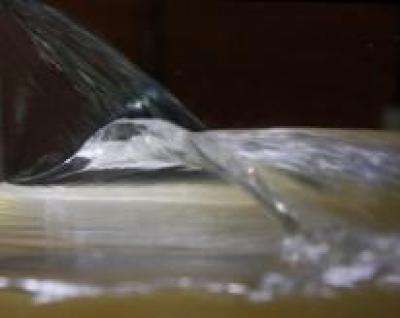A scientific experiment is able to create a wave that is frozen in time

"A wave is a deformation in the surface of a liquid that moves at a speed that is independent of that liquid," the researchers explain. For example: in the waves that are formed when a rock is thrown into a pond, the water remains still while the waves move away from the center at their own speed. "In our case, what occurs is actually the opposite: the water moves very rapidly (at several meters per second), but the wave moves at a speed of zero. That is, it remains still, "frozen" in time for any observer who sees it from outside of the water," explains one of the authors of the research report, Javier Rodríguez, of UC3M's Fluids and Thermal Engineering Department.
Every surfer's dream
In this experiment, which is described in an article published in the journal Experiments in Fluids, the scientists used digital processing techniques and visualization techniques that used a laser to reconstruct the form of the wave in three dimensions in order to compare it with real waves, similar to those that are ridden by surfers. "The most remarkable thing is to observe a pipeline wave that remains still, to the point that we can put our fingers under the crest for as long as we want and not get wet, because this wave never breaks," describes Javier Rodríguez.
In order to recreate this phenomenon, the scientists constructed a small canal in a laboratory at the University. The prototype is relatively simple, they say: it consists of a semi-submerged panel with a square corner that partially obstructs the flow in a tank of water that is approximately the length of a van. "This is the simplest and cheapest way to produce different heights in a very rapidly moving current of water," states Professor Rodríguez.
In the theoretical part of the study, in which the UC3M scientists are currently collaborating with colleagues from UC San Diego (USA) and from the University of East Anglia (United Kingdom), they are using computer simulation techniques and asymptotic analysis to create an approximate description of this wave's formation. "This description is precise enough to enable us to understand its behavior; we are taking advantage of the fact that the wave is very slender. That is, as we move away from its starting point, its size slowly increases," points Pablo Martínez-Legazpi, a researcher at UC San Diego. "As we investigate further into this subject," he adds, "we realize that this formation process is representative of and common to other waves that are of great interest to civil and naval engineering, such as waves that crash into ports, bridges or off-shore oil rigs during rough sea conditions."
Structural and environmental applications Thanks to this experiment, it is possible to generate a wave that would never be static in Nature and to render it motionless in the laboratory for the time that is necessary to study it in detail. Understanding how these waves are formed can be tremendously useful when predicting the intensity of the streams that appear when waves impact against marine structures (ports, off-shore oil rigs, ships, etc.) and it could help to anticipate the damage that they might cause. In fact, this research was suggested and partially financed by the US Navy due to its implications for improvements in naval hydrodynamics.
From the oceanographic point of view, this is also a very useful tool, as it allows for the implementation of a great number of research techniques that would be very difficult to apply to a wave in motion. In addition, it has direct environmental applications: it allows for a better response to what occurs on the marine surface when a wave breaks, which in turn can help scientists understand how carbon dioxide exchange between the ocean and atmosphere occurs. "And although it has nothing to do with science, we also think this research can be of interest when it comes to creating decorative fountains or rides in water parks," notes Javier Rodríguez. "If, in addition to being interesting because it can help us understand the ocean, you can also have fun with it, why not do it?" he concludes.
More information: Experiments in Fluids. Volume: 54. Number: 1. Article number: 1437. DOI: 10.1007/s00348-012-1437-7
Provided by Carlos III University of Madrid


















